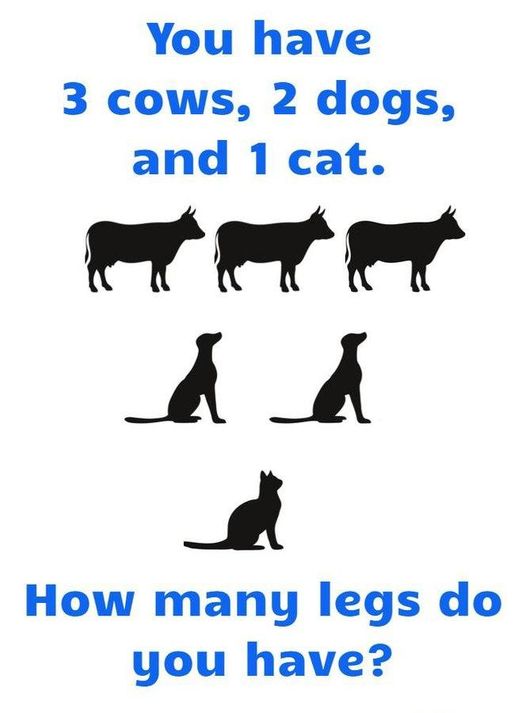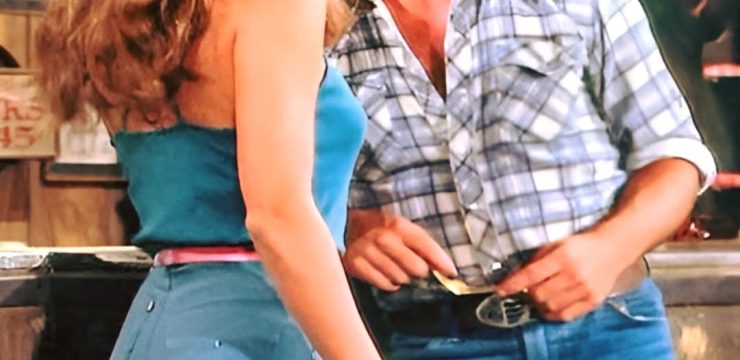At first glance, this question seems like a simple math problem. With a quick calculation, you might think you need to add up the number of legs on all the animals mentioned: three cows, two dogs, and one cat. However, the trick lies in the wording, and the answer is not what you might expect. Let’s break down the details and understand the clever twist behind this riddle.

Breaking Down the Animal Legs
First, let’s calculate the number of legs for each animal mentioned in the riddle.
- Cows: Cows are four-legged animals, and there are three of them in the question. To find the total number of legs for the cows:
- 4 legs per cow × 3 cows = 12 legs.
- Dogs: Like cows, dogs also have four legs. With two dogs, the total number of legs for the dogs is:
- 4 legs per dog × 2 dogs = 8 legs.
- Cat: Finally, we have one cat, which also has four legs. So, for the single cat:
- 4 legs per cat × 1 cat = 4 legs.
Now that we’ve calculated the number of legs for each animal, we can add them together to get the total:
- 12 legs from the cows, 8 legs from the dogs, and 4 legs from the cat.
So, 12 + 8 + 4 = 24 legs in total for all the animals.
At this point, you might think the answer is 24, but that’s where the trick comes in. This riddle is designed to make you focus on the animals, but the question is actually asking about your legs.
The Trick in the Riddle
The key to this riddle lies in the wording of the question. While you’re busy adding up the legs of the animals, you may not realize that the question isn’t really asking about the animals at all. Instead, it asks, “How many legs do you have?”
This is where the clever trick happens. The mention of cows, dogs, and a cat is meant to distract you. The question doesn’t ask how many legs the animals have in total—it’s asking about your legs, as the reader.
The Correct Answer
The correct answer to this riddle depends on the number of legs you have, not the animals. If you’re reading this riddle, and assuming you are a typical human being, you most likely have two legs. So, the correct answer is:
- 2 legs.
Even though the question begins by listing the animals and their legs, the focus shifts to you as the reader. The question asks how many legs you have, and for most people, that would be two.
The Lesson Behind the Riddle
This riddle serves as a fun reminder to always read the question carefully. It’s easy to get caught up in details that seem important, like calculating the number of legs for all the animals, but the real answer lies in paying attention to what the question is truly asking.
The riddle plays with your expectations, making you think that the focus is on the animals when, in reality, the question is all about you. It’s a clever way to test your attention to detail and challenge your assumptions.
Why This Riddle Works
The reason this riddle works so well is because it leads you down a path that seems logical—counting the legs of the animals. It taps into the natural human tendency to solve problems quickly without fully analyzing the question. By the time you’ve done the math and calculated 24 legs, you feel confident in your answer, only to realize that the question wasn’t really about the animals after all.
This type of puzzle is effective because it forces you to think beyond the obvious. It teaches an important lesson: sometimes, the obvious answer isn’t the correct one, and careful reading is necessary to avoid being misled.
Final Thoughts
The riddle, “You have 3 cows, 2 dogs, and 1 cat. How many legs do you have?” is a great example of how language can be used to play with our expectations. While it might seem like a straightforward math problem at first, the true answer lies in focusing on the reader rather than the animals. The answer is simply two legs, referring to your own.
This riddle is a fun and clever way to remind us that things aren’t always what they seem, and sometimes, the key to solving a problem is to think beyond the obvious. So, the next time you come across a tricky question, remember to pause, think, and read carefully—you might just find that the answer is simpler than it first appears!





